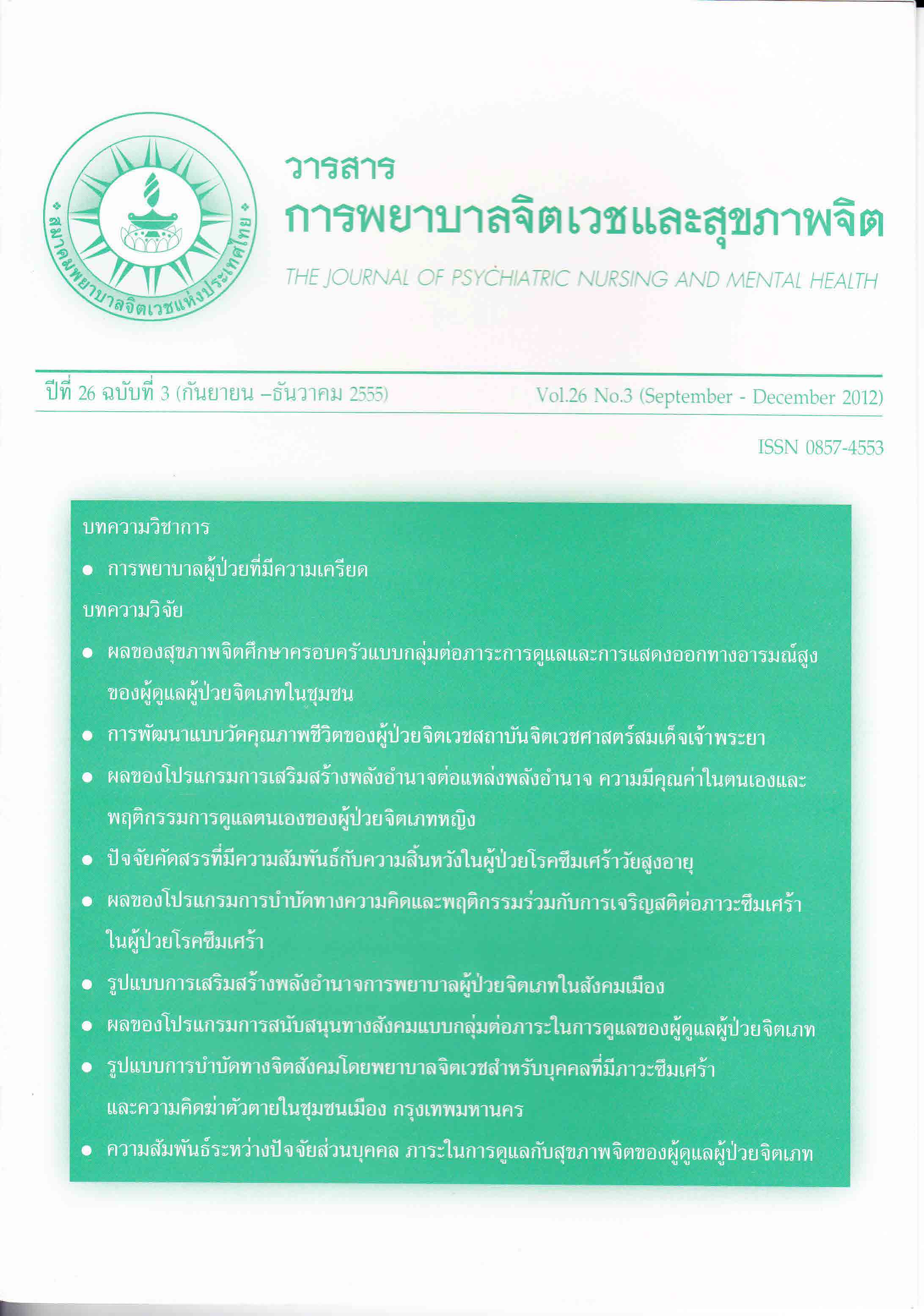ปัจจัยคัดสรรที่มีความสัมพันธ์กับความสิ้นหวังในผู้ป่วยโรคซึมเศร้าวัยสูงอายุ
Main Article Content
บทคัดย่อ
บทคัดย่อ
การวิจัยครั้งนี้เป็นการวิจัยเชิงบรรยายมีวัตถุประสงค์เพื่อศึกษา 1) ความสิ้นหวังของผู้ป่วยโรคซึมเศร้าวัยสูงอายุและ 2)ความสัมพันธ์ระหว่างปัจจัยคัดสรร ได้แก่ อายุ เพศ ความเชื่อและการปฏิบัติกิจกรรมทางศาสนา ประสบการณ์ความเครียดในชีวิต ภาวะซึมเศร้า ความรู้สึกมีคุณค่าในตนเอง การสนับสนุนทางสังคม และความสิ้นหวังของผู้ป่วยโรคซึมเศร้าวัยสูงอายุกลุ่มตัวอย่าง คือ ผู้ป่วยโรคซึมเศร้าที่มีอายุ 60 ปีบริบูรณ์ขึ้นไป คัดเลือกโดยสุ่มอย่างง่ายที่แผนกผู้ป่วยนอก โรงพยาบาลราชบุรี โรงพยาบาลพหลพลพยุหเสนา โรงพยาบาลมะการักษ์และ จำนวน 156 คน เครื่องมือรวบรวมข้อมูลคือ 1) แบบสอบถามข้อมูลส่วนบุคคล 2) แบบประเมินประสบการณ์ความเครียดในชีวิต 3) แบบวัดความเศร้าในผู้สูงอายุไทย 4) แบบสอบถามความรู้สึกมีคุณค่าในตนเอง 5) แบบสอบถามการสนับสนุนทางสังคมและ 6) แบบประเมินความสิ้นหวังของผู้สูงอายุ เครื่องมือทุกชุดได้รับการตรวจสอบความตรงเชิงเนื้อหาContent Validity Index (CVI > .80) โดยผู้ทรงคุณวุฒิจำนวน 5 ท่าน และความเที่ยงสัมประสิทธิ์แอลฟาของครอนบาค (Crinbach’s alpha coefficient)ของเครื่องมือชุดที่ 2-6 เท่ากับ .85, .79, .78, .73และ.77 ตามลำดับ วิเคราะห์ข้อมูลโดยใช้สถิติพื้นฐาน จำนวนร้อยละ ค่าเฉลี่ย ส่วนเบี่ยงเบนมาตรฐาน ค่าสัมประสิทธิ์อีตาและสัมประสิทธิ์สหสัมพันธ์เพียร์สัน
ผลการวิจัยพบว่าความสิ้นหวังในผู้ป่วยโรคซึมเศร้าวัยสูงอายุอยู่ในระดับปานกลาง( = 15.87, ± SD = 5.40) ประสบการณ์ความเครียดในชีวิตความรู้สึกมีคุณค่าในตนเองการสนับสนุนทางสังคมมีความสัมพันธ์ทางลบในระดับต่ำกับความสิ้นหวังในผู้ป่วยโรคซึมเศร้าวัยสูงอายุ (r = - .200, p < .05, r = -.581, r = -.481,p < .01 ตามลำดับ) ภาวะซึมเศร้ามีความสัมพันธ์ทางบวกในระดับปานกลางกับความสิ้นหวังในผู้ป่วยโรคซึมเศร้าวัยสูงอายุ (r = .670, p < .01)
คำสำคัญ : ความสิ้นหวัง, ผู้ป่วยวัยสูงอายุ, โรคซึมเศร้า
Abstract
The purpose of this descriptive research was to examine : 1) hopelessness among elderly patients with Major Depression and 2) the relationships between age, gender, religious belief / activities, stressful life event, depression, self–esteem, social supports and hopelessness. A Sample of 156 patients with Major Depression, aged 60 years and older were randomly selected from the out patient department at Ratchaburi Hospital, Pahonponpayuhasana Hospital, and Makarak Hospital. The research instruments were: 1) Personal data questionnaire, 2) Geriatric Social Readjustment Rating Scale (GSRRS), 3) Thai Geriatric Depression Scale (TGDS), 4) Self Esteem Scale, 5) The personal resource questionnaire (PRQ85), and 6) GeriatricHopelessness Scale (GSH). All instruments were verified for Content Validity Index (CVI > .80) by five experts and reliability of the 2rd–6th questionnaires by Cronbach’s alpha coefficient were .85, .79, .78, .73 and .77. Data were analyzed by using descriptive statistics, Eta Coefficient and Pearson’s Product Moment Correlation.
The results revealed that the mean score of hopelessness was at the moderate level ( =15.87, ± SD = 5.40). Stressful life event, self–esteem, social support were statistically significant low negative correlation with hopelessness among elderly patients with Major Depression (r = -.200, p < .05, r = -.581, r = -.481, p < .01 respectively). Depression was statistically significant moderate positive correlation with hopelessness among elderly patients with Major Depression (r = .670, p < .01).
Keywords : Hopelessness, Elderly patients, Major depression
Article Details
บทความที่ได้รับการตีพิมพ์แล้ว เป็นลิขสิทธิ์ของสมาคมพยาบาลจิตเวชแห่งประเทศไทย


